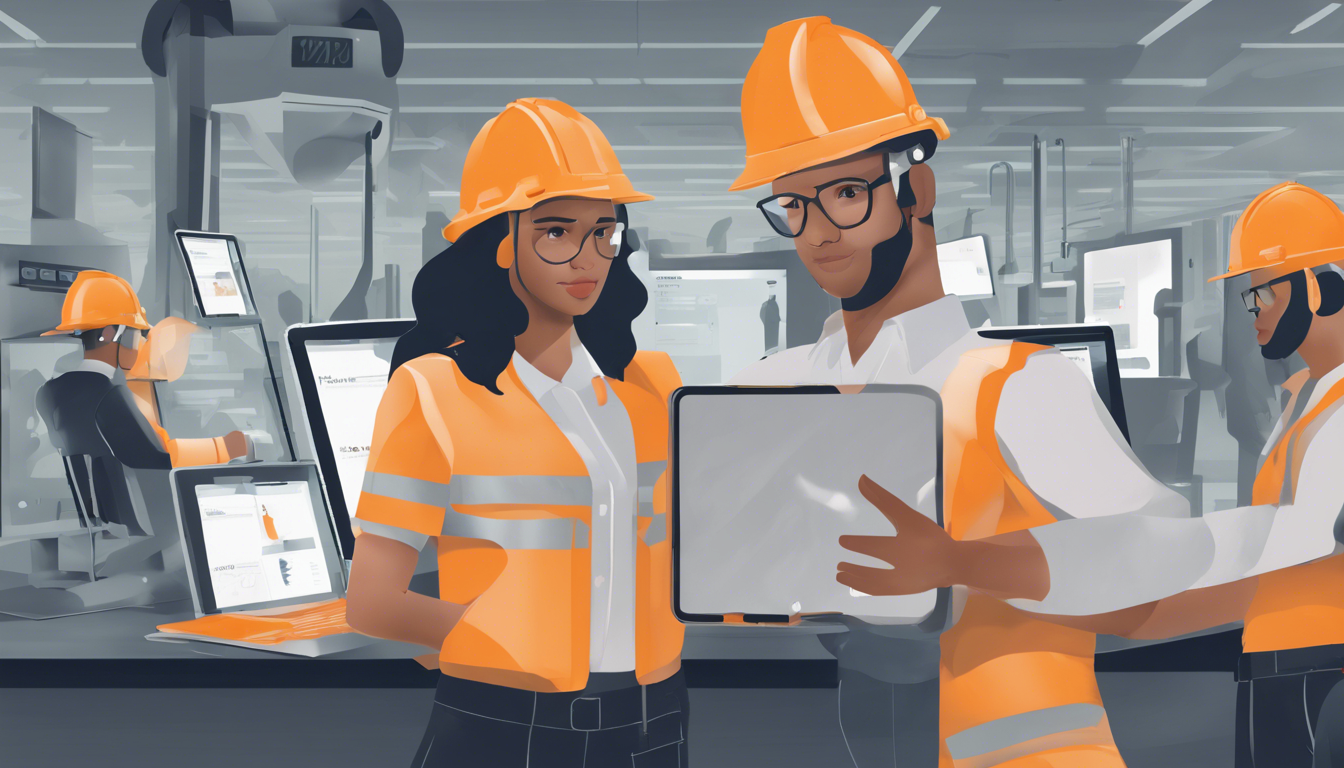
Revolutionizing Workplace Safety: How AI-Driven Safety Management Enhances Protection and Efficiency
In today’s rapidly evolving work environment, ensuring the safety of employees while maintaining operational efficiency has become a paramount concern for business owners and safety professionals alike.
AI-driven safety management systems are at the forefront of this revolution, offering innovative solutions that enhance workplace protection through advanced technology.
This article delves into the essential components of AI-driven safety management, exploring its numerous benefits, practical implementations, and real-world applications across various industries.
Join us as we examine how embracing AI can not only safeguard your workforce but also streamline safety processes for a more efficient organization.
Transform Your Safety Management with AI-Powered Tools

Key Takeaways
- AI-driven safety management significantly improves workplace protection and operational efficiency.
- Implementing AI technologies can lead to proactive safety measures and risk mitigation.
- Real-world case studies demonstrate the successful integration of AI in various industries.
- Challenges exist in adopting AI safety solutions but can be overcome with the right strategies.
- The future of workplace safety will increasingly rely on AI to enhance safety protocols and compliance.
Understanding AI-Driven Safety Management
Understanding AI-driven safety management is imperative for business owners and safety professionals aiming to enhance workplace safety protocols.
AI-driven safety management employs advanced algorithms and machine learning techniques to predict and mitigate risks, significantly reducing the likelihood of workplace accidents.
The benefits of integrating AI technologies in safety management systems include real-time hazard detection, automated reporting, and comprehensive analytics that foster proactive safety measures.
For example, implementing AI-driven solutions can facilitate continuous monitoring of conditions and behaviors that contribute to unsafe environments, allowing organizations to address issues before they escalate.
Across various industries, case studies illustrate successful AI safety management applications, such as predictive maintenance in manufacturing that sharply decreased equipment failures and incidents.
However, challenges remain, including data privacy concerns and the need for employee buy-in for technology adoption.
As we look to the future, AI-driven safety management promises to evolve further with innovations like wearables that monitor worker health, indicating that this digital transformation will play a crucial role in redefining workplace safety standards.
Benefits of AI in Workplace Safety
AI-driven safety management is revolutionizing the way businesses approach workplace safety, providing a plethora of benefits that enhance preventive measures and incident response.
By harnessing machine learning algorithms and data analytics, AI technologies can identify patterns related to accidents and near-misses, enabling organizations to proactively address potential hazards before they escalate.
The implementation of AI-driven solutions, such as real-time monitoring systems and predictive analytics, allows safety professionals to develop data-informed strategies that significantly reduce risks and improve compliance.
Case studies from various industries illustrate the successful integration of AI technologies, demonstrating reduced injury rates and enhanced employee safety culture.
However, the adoption of AI-driven safety management is not without its challenges, including the need for proper training, integration with existing safety protocols, and addressing employee concerns about surveillance.
As businesses continue to evolve in an increasingly digital landscape, the future of AI-driven safety management holds promise, with the potential for even more advanced solutions that anticipate risks and optimize safety outcomes in dynamic work environments.
‘The future belongs to those who believe in the beauty of their dreams.’ – Eleanor Roosevelt
Transform Your Safety Management with AI-Powered Tools
Implementing AI Technologies for Safety Management
Implementing AI-driven safety management systems is becoming an essential strategy for business owners and safety professionals seeking to enhance workplace safety and efficiency.
By leveraging advanced machine learning algorithms and analytics, organizations can proactively identify potential hazards and mitigate risks before they lead to incidents.
AI technology can analyze vast amounts of data from various sources, including employee reports, equipment performance, and environmental conditions, to offer predictive insights and actionable recommendations.
For instance, AI can streamlining safety training by personalizing modules based on individual employee performance and risk exposure, ensuring that teams are better prepared to respond to emergencies.
Furthermore, real-time monitoring systems equipped with AI capabilities can detect deviations in operational protocols, allowing for immediate corrective actions.
As businesses increasingly prioritize safety, the integration of AI-driven safety management not only fosters a safer work environment but also reduces operational costs and boosts overall productivity.
Case Studies: Successful AI Safety Management in Industries
In recent years, various industries have successfully implemented AI-driven safety management systems that have not only enhanced workplace safety but also optimized operational efficiency.
For instance, a prominent construction firm adopted an AI-powered safety platform that utilized machine learning algorithms to analyze real-time data from wearable devices worn by workers on site.
This system was able to predict potential hazards by monitoring environmental conditions and worker behavior, thereby allowing safety managers to proactively address risks before incidents occurred.
Another case study in the manufacturing sector illustrated how an AI-driven safety management system integrated computer vision technology to monitor compliance with safety protocols on the production floor.
By automatically detecting unsafe practices—such as the improper use of equipment or the lack of personal protective gear—the system provided immediate feedback to operators and facilitated targeted training.
These examples underscore the transformative impact of AI-driven solutions in creating safer work environments, ultimately resulting in reduced accident rates and enhanced employee morale, crucial metrics for business owners and safety professionals alike.
Challenges and Considerations in Adopting AI Safety Solutions
Adopting AI-driven safety management solutions presents a unique set of challenges and considerations that demand careful attention from business owners and safety professionals alike.
Firstly, integrating such technology into existing systems can be complex, often requiring substantial changes to infrastructure and workflows, which may disrupt operations during the transition phase.
Additionally, ensuring data privacy and security is paramount, as these solutions rely heavily on collecting and analyzing sensitive information about workforce behavior and safety incidents.
Furthermore, there’s the challenge of fostering a culture that embraces AI tools; employees must be adequately trained to trust and utilize these technologies effectively while understanding their benefits in enhancing workplace safety.
It’s also critical to navigate regulatory compliance, as various industries may have specific safety standards that AI applications must align with.
Finally, ongoing evaluation of AI effectiveness and the continuous improvement of algorithms are essential to maintain safety outcomes, which necessitates a committed investment of time and resources from organizations.
Addressing these challenges head-on is key to successfully leveraging AI-driven safety management for a safer working environment.
The Future of AI-Driven Safety Management in Workplaces
As businesses increasingly recognize the importance of maintaining a safe work environment, the future of AI-driven safety management is poised to transform how organizations approach workplace safety protocols.
By incorporating advanced machine learning algorithms and predictive analytics, AI systems can identify potential hazards before they result in accidents, streamline compliance with safety regulations, and enhance employee training programs through real-time feedback mechanisms.
For business owners and safety professionals, this means not only a reduction in workplace injuries but also significant cost savings through minimized insurance claims and improved operational efficiency.
Moreover, the integration of AI-powered tools can foster a culture of proactive safety management, empowering employees to participate actively in recognizing and mitigating risks.
As technology continues to evolve, those who strategically implement AI-driven safety management solutions will not only safeguard their workforce but also position themselves as industry leaders in fostering sustainable and secure work environments.
Frequently Asked Questions
What is AI-driven safety management?
AI-driven safety management refers to the use of artificial intelligence technologies to enhance workplace safety practices.
This involves utilizing data analytics, machine learning, and predictive models to identify potential hazards, improve safety protocols, and ensure compliance with regulations.
What are the benefits of implementing AI in workplace safety?
The benefits of AI in workplace safety include improved hazard identification, reduced incident rates, enhanced data analysis for better decision-making, increased efficiency in safety management processes, and the ability to provide real-time monitoring and feedback.
How can businesses implement AI technologies for safety management?
Businesses can implement AI technologies for safety management by assessing their specific safety needs, investing in appropriate AI tools and software, training staff on how to use these technologies, and establishing protocols for data collection and analysis.
What are some successful case studies of AI safety management in industries?
Successful case studies of AI safety management can be found in various industries such as manufacturing, construction, and healthcare, where companies have implemented AI-driven systems to significantly reduce workplace incidents and improve safety compliance.
What are the challenges of adopting AI safety solutions?
Challenges in adopting AI safety solutions include resistance to change from employees, the high cost of technology implementation, the need for ongoing training, and potential concerns about data privacy and security.
Related Post
Recent Posts
- Revolutionizing Water Safety Monitoring: How AI is Making Waves in Environmental Protection
- Transforming Workplace Safety: The Impact of AI-Driven Safety Culture Programs
- Revolutionizing Workplace Safety: The Role of AI in Smart PPE Technology
- Revolutionizing Workplace Safety: How AI-Driven Solutions Enhance Health and Security
- Revolutionizing Marine Safety: How AI is Transforming Safety Systems on the High Seas


